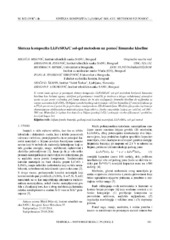Приказ основних података о документу
Synthesis of Li2FeSiO4/C composite by sol-gel citric acid assisted method
Sinteza kompozita Li2FeSiO4/C sol-gel metodom uz pomoć limunske kiseline
| dc.creator | Milović, Miloš | |
| dc.creator | Jugović, Dragana | |
| dc.creator | Mitrić, Miodrag | |
| dc.creator | Stojković Simatović, Ivana | |
| dc.creator | Škapin, Srečo Davor | |
| dc.creator | Uskoković, Dragan | |
| dc.date.accessioned | 2018-06-09T10:19:39Z | |
| dc.date.available | 2018-06-09T10:19:39Z | |
| dc.date.issued | 2016 | |
| dc.identifier.issn | 0040-2176 | |
| dc.identifier.uri | https://scindeks.ceon.rs/article.aspx?artid=0040-21761602181M | |
| dc.identifier.uri | http://www.ncbi.nlm.nih.gov/pubmed/0040-21761602181M | |
| dc.identifier.uri | https://dais.sanu.ac.rs/123456789/3360 | |
| dc.description.abstract | This paper describes a procedure for the synthesis of the composite Li2FeSiO4/C by sol-gel method using citric acid as a chelating agent; the resulting gel precursor was thermally treated in a slightly reductive atmosphere of nitrogen with five percent of hydrogen, whereupon the in situ decomposition of citric acid to carbon occurs during formation of the Li2FeSiO4. The obtained nanocrystalline powder (with mean crystallite size of 27nm) crystallized in the P21/n space group as confirmed by X-ray diffractometry. The morphology of the powder was examined by scanning electron microscopy which revealed a wide distribution of particles by size, from 100 to 500 nm. The material has been tested as cathode in lithium-ion cell and exhibits high efficiency and almost theoretical capacity. | en |
| dc.description.abstract | U ovom radu opisan je postupak sinteze kompozita Li2FeSiO4/C sol-gel metodom koristeći limunsku kiselinu kao helatni agens; dobijeni gel-prekursor termički je tretiran u blago redukcionoj atmosferi azota sa pet posto vodonika, pri čemu dolazi do in situ razlaganja limunske kiseline do ugljenika za vreme nastanka Li2FeSiO4. Dobijeni nanokristalniprah (srednje veličine kristalita 27 nm) kristalisao je u P21/n prostornoj grupi što je potvrđeno rendgenskom difraktometrijom. Morfologija praha ispitana je skanirajućom elektronskom mikroskopijom koja otkriva široku raspodelu čestica po veličini, od 100 - 500 nm. Materijal je ispitan kao katoda u litijum-jonskoj ćeliji i pokazuje visoku efikasnost i praktično teorijski kapacitet. | sr |
| dc.publisher | Belgrade : Union of Engineers and Technicians of Serbia | |
| dc.relation | info:eu-repo/grantAgreement/MESTD/Integrated and Interdisciplinary Research (IIR or III)/45004/RS// | |
| dc.rights | openAccess | |
| dc.rights.uri | https://creativecommons.org/licenses/by/4.0/ | |
| dc.source | Tehnika | |
| dc.title | Synthesis of Li2FeSiO4/C composite by sol-gel citric acid assisted method | en |
| dc.title | Sinteza kompozita Li2FeSiO4/C sol-gel metodom uz pomoć limunske kiseline | sr |
| dc.type | article | en |
| dc.rights.license | BY | |
| dcterms.abstract | Ускоковић, Драган; Миловић, Милош; Шкапин, Сречо Давор; Стојковић Симатовић, Ивана; Митрић, Миодраг; Југовић, Драгана; Синтеза композита Ли2ФеСиО4/Ц сол-гел методом уз помоћ лимунске киселине; | |
| dc.citation.spage | 181 | |
| dc.citation.epage | 184 | |
| dc.citation.volume | 71 | |
| dc.citation.issue | 2 | |
| dc.identifier.doi | 10.5937/tehnika1602181M | |
| dc.type.version | publishedVersion | |
| dc.identifier.fulltext | https://dais.sanu.ac.rs/bitstream/id/10697/0040-21761602181M.pdf | |
| dc.identifier.rcub | https://hdl.handle.net/21.15107/rcub_dais_3360 |

